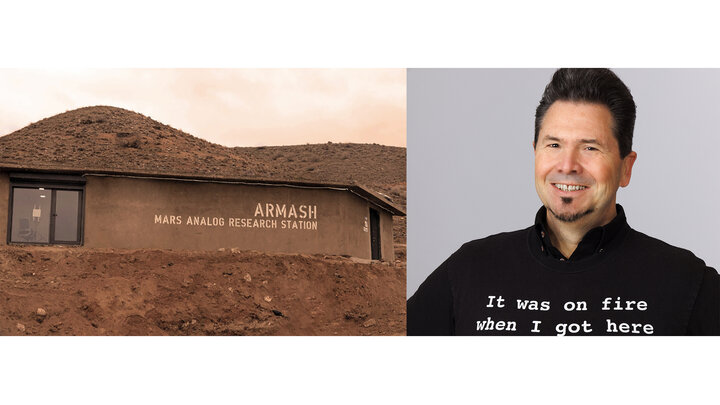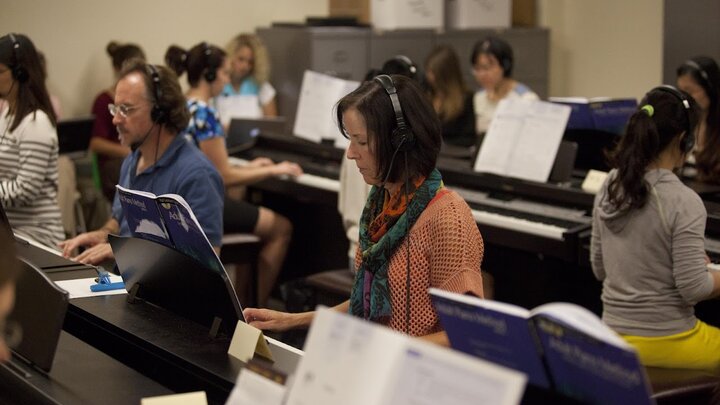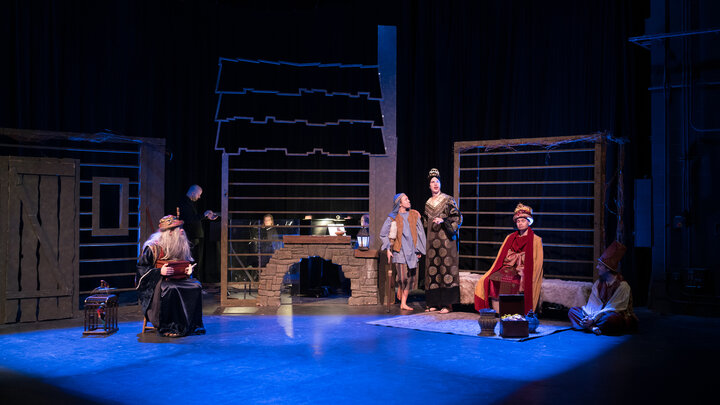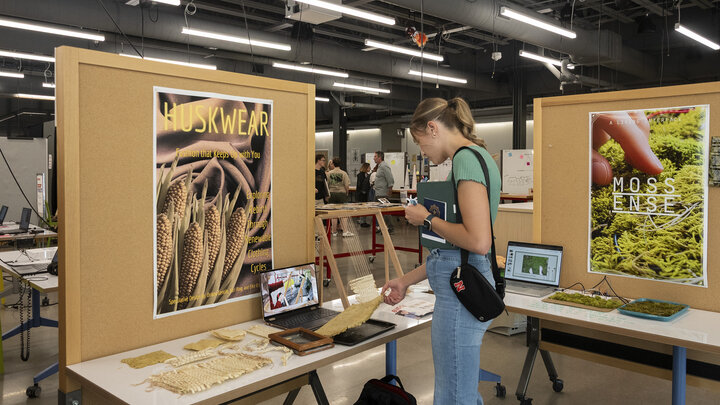Lincoln, Neb.--Dan “NovySan” Novy, assistant professor of emerging media arts in the Johnny Carson School of Theatre and Film, has been selected to participate as a communications officer in the upcoming analog astronaut mission with the Armenian Space Forum in Armash, Armenia, at the Mars Analog Research Station.
“I will be like Uruha [from ‘Star Trek’],” Novy said. “I will be in charge of communications between the habitat and our local mission control (MCC), and then that MCC will be in contact with the main MCC in Vienna, Austria, run by the Austrian Space Forum. I was originally tapped to be at main mission control in Vienna, and I did accept. However, I said, caveat, if I get an astronaut assignment, I’m definitely taking it. They said that’s completely understandable. I got a few interviews at a couple of other habitats and then was eventually invited to go to Armenia.”
The station is one of the flagship independent habitats for the World’s Biggest Analog (WBA) initiative. Analogs help scientists prepare for space by simulating missions on Earth. The WBA is an international collaboration of researchers, educators and entrepreneurs embarking on a mission to unite the world’s analogs through a single mission coordinated around the globe for two weeks in October. The mission will integrate more than forty elite analog astronauts at 16 analog research stations located across the world.
Novy’s mission will take place from Oct. 10-27 and will simulate planetary surface operations under isolated, confined and extreme conditions, reflecting the challenges of future Martian expeditions. He is one of six analog astronauts on his crew from around the world.
“It’s a short mission,” he said. “There are, I want to say, a dozen scientific experiments that each of the habitats will be involved in.”
Exploration is an important theme in Novy’s research.
“As a student at the MIT Media Lab, I was involved in the Space Exploration Initiative, which began in 2017. In fact, I helped plan and execute the very first Beyond the Cradle space exploration conference at the MIT Media Lab, and ever since then, I was just involved, as a student, doing all sorts of things with space exploration while I was also doing ocean exploration, so exploration is sort of a theme within my research. Action, adventure, exploration—it’s what I love. It’s what drives me.”
Novy is currently part of Ocean Discovery League’s $1.2 million NOAA grant for development of its next-generation deep ocean sensor system. The project was recently featured in “National Geographic” magazine.
One of the guests invited to that first Beyond the Cradle conference was Sheyna Gifford, an aerospace researcher and rehabilitation physician, who introduced Novy to the concept of analog astronauts.
“She is one of around 25 space doctors,” Novy said. “She also happened to be an analog astronaut. She was describing that and what it was, and my ears perked up, and I said, wait, how do you become one? There’s a couple of private training companies that you can sign up with. It’s about a year and a half of training, most of it is virtual online, but some in person. And then there’s an annual Analog Astronaut Conference, which takes place in Biosphere 2 every year. Once you complete the training, you can apply to any of the habitats that have missions that need astronauts.”
Novy completed his training earlier this year. For him, this is a dream come true.
“I just love space,” Novy said. “Ever since I was a kid, I’ve dreamed of the stars. But I didn’t really see a way forward in the 70s and 80s when I was growing up, so it was not something I thought that was even possible. I have this term called ‘space within reach.’ Space is becoming more within reach, especially given the amount of NGO (non-governmental organization) and private commercial space launches that we are having. A lot of the basic launches are being handed over away from NASA, leaving NASA to do the more important scientific discovery that it really should be doing.”
With that privatization is the ability to bring in more people to space exploration.
“The Space Exploration Initiative at the MIT Media Lab was really all about democratizing access to space, in addition to using the tools of space to improve life here on Earth,” Novy said. “Every time we run an analog, every time we run a simulation, we learn something that will be useful for launch, but generally shows some kind of benefit for life back here on Earth as well. There’s some scientific discovery that happens every time you run a simulation.”
Novy said he’s doing this not just for himself, but for his students as well.
“I really want my students to see that space or exploration, in general, is something that they can do, especially as emerging media artists,” he said. “A lot of people might say, what is an artist doing working in the space industry? But if you look very closely at what space analog is, it’s a simulation. It’s very much a form of immersive theatre, and there are some elements of role-playing, and that’s something I study as a theatre and media professional. The idea is how can we apply things like escape room mechanics and virtual production methodologies and technologies to increase the fidelity of the simulation and thereby get better results.”
The goal is to make things as real as possible for the analog astronauts.
“Even with the habitat I’m going to in Armenia, there are windows outside, and it looks exactly like Mars. However, we will be seeing the Earth’s day and night cycle, and so our body rhythms aren’t going to sync up with the Martian day and night cycle,” he said. “But if you were to, say, have an LED capture volume, similar to what was used in ‘The Mandalorian’ or what we teach here at the Johnny Carson Center, you could use a game engine to have the correct Martian day and night cycle. The goal is increased fidelity—better results.”
Novy’s ultimate goal would be to establish a ground-based analog research station in Nebraska.
“Nebraska does not yet have a space analog habitat, and yet, in the western part of the state, we have definitely something that is analogous to Mars, especially if you go deeper in,” he said. “We have decommissioned missile silos, which could be refactored, reformed, redecorated and turned into either transit vehicles or habitat.”
And might going into space, for real, be an option for Novy someday?
“I wouldn’t say it’s a hard goal, but I wouldn’t say no, right? I’ve often told my wife if I’m offered the chance to go, even to Mars, I’m going to take it. She says yes, as long as it’s not one way,” he said.
But it’s been on his mind for a long time.
“I want to say I was 13 years old when the Atari 2600 Space Shuttle game came out,” Novy said. “And it was amazing because it had this whole fold-out overlay that went over the 2600 console, and. You used all the buttons on the console, and it was essentially a simulated Space Shuttle mission. And of course, being me, I took it a step further, and I took an old refrigerator box and laid it on its side. I put a folding chair on its back. I cut a hole in the box and anchored a TV on top of it. And so I built, essentially, a space shuttle simulator in my basement to play this game. I’ve always said I think that was my start as an astronaut. It was just really wanting to sort of build a simulator, and now, here I am doing simulation 40 years later.”
To say he’s looking forward to the experience would be an understatement.
“I’m looking forward to just experiencing everything. I’ve been on a lot of ships. I’ve done deployments of scientific equipment off of ships. Living in small quarters, deploying off very small vehicles, it will be interesting to see how space will differ from ocean exploration, but I think one will help inform the other,” he said.
But it’s still a new experience for him.
“This is a new thing for me, and I’m super excited,” he said. “I would just like my students to dream bigger and realize that things like space and ocean exploration are things that are within their reach, and that they can do. It’s just a matter of going out there and finding it.”



